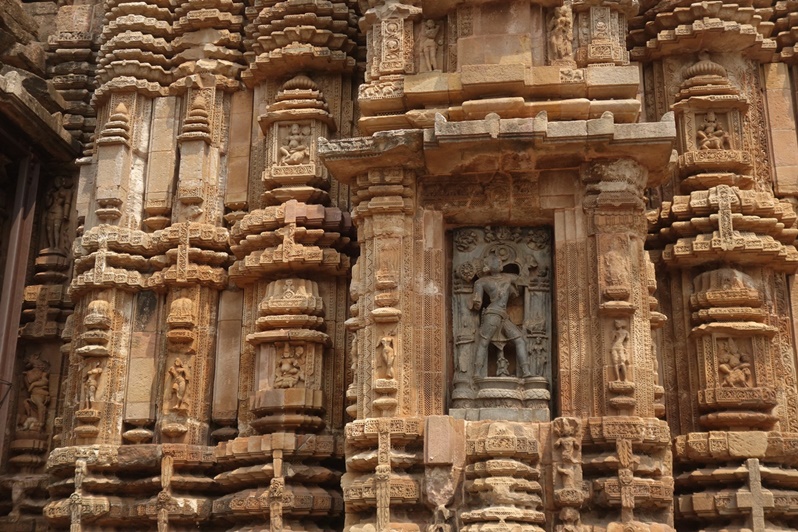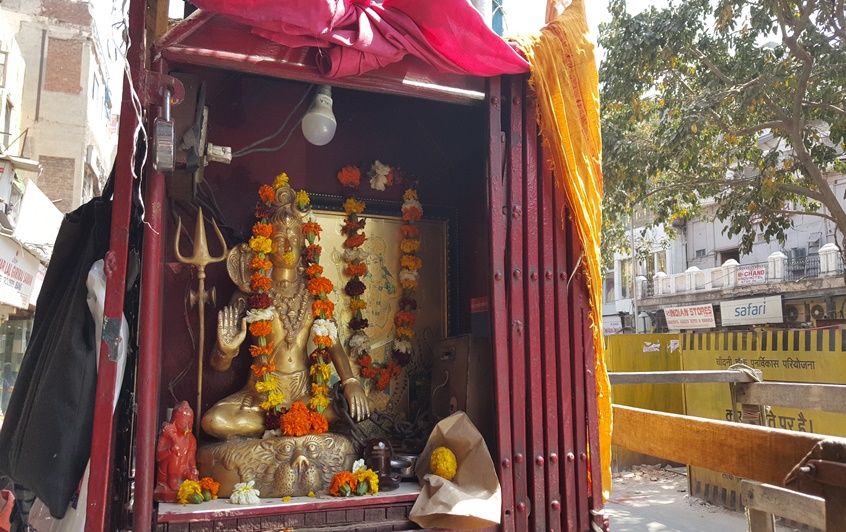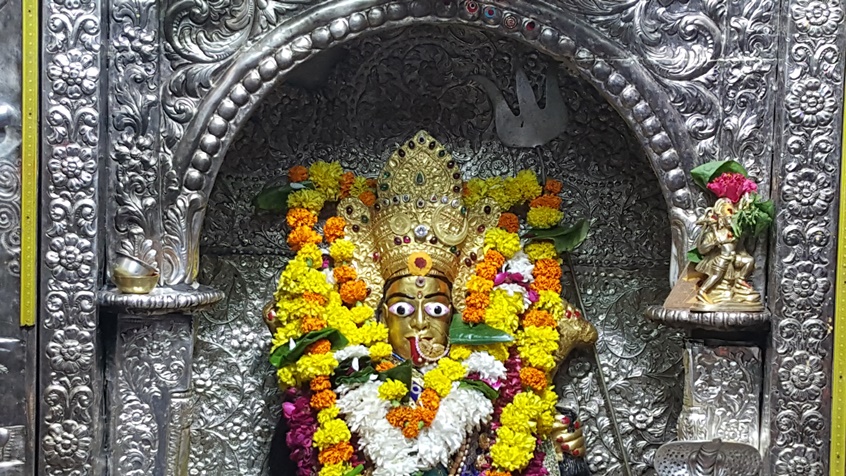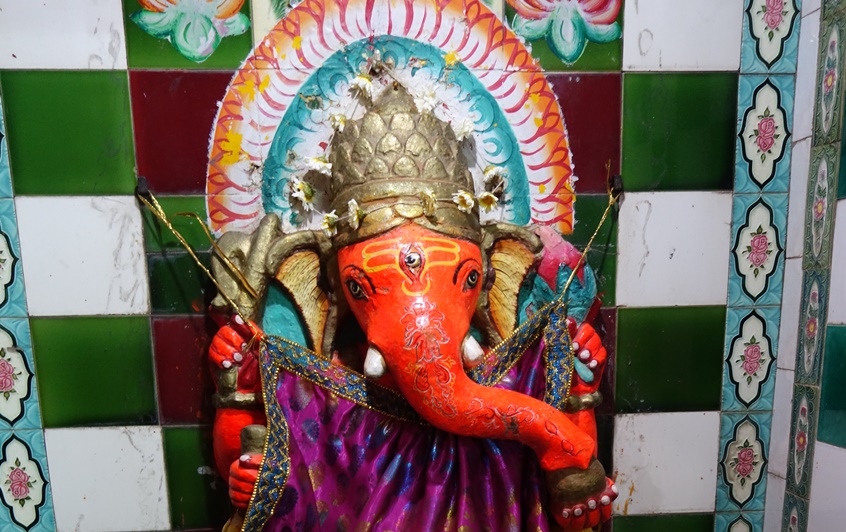
par Bertrand Bellaize, le 21 mars 2022
Hindouisme : divinités hindoues. Ganesha, Celui qui lève les obstacles.
Ganesha dans le panthéon hindou est un des fils de Shiva et Parvati (avec Skanda). Il symbolise la richesse, la sagesse, la chance.
Il est représenté par un homme avec une tête d’éléphant, c’est le dieu hindou le plus facilement reconnaissable.
Et c’est sans doute la divinité la plus populaire, la plus vénérée de l’Inde. Les fidèles ne manquent pas de l’honorer avant toute entreprise : voyage, démarches… tout projet, quel qu’il soit fait l’objet d’une prière à Ganesha avant sa mise en œuvre. Ganesha est celui qui lèvent les obstacles (ou peut les multiplier), il est alors nommé Vighneswara.
L’histoire de sa naissance, la plus connue, est celle où Parvati, seule, se languissait des longues absences de Shiva : un jour lui vint l'idée de modeler un fils, à qui elle donna vie dans le Gange. Elle le chargea de garder ses appartements et de ne laisser entrer personne sous aucun prétexte. Shiva, rentrant chez lui, trouva un jeune homme devant sa porte : furieux, il le décapita avec son trident. Indignée et courroucée Parvati exigea auprès des Dieux qu'ils ramènent son fils à la vie avant la fin du jour : les dieux décidèrent de couper la tête du premier nouveau né trouvé qui se trouva être un éléphanteau !
Ganesha est considéré par ses disciples les plus fervents comme le Dieu suprême, au-delà des dieux de la Trimurti (Brahma, Vishnou et Shiva).
En effet Gana signifie catégories ; les catégories permettent de mesurer (établir un rapport à autre chose, mettre en relation), de différencier, de mettre des limites entre les différentes formes.
Ganesha représente la communion du macrocosme et du microcosme, l’un étant à l’image de l’autre, l’un contenant l’autre.
En effet , au-delà de l’anecdotique histoire de sa naissance, la forme de Ganesha est particulièrement intéressante : l’éléphant symbolise le macrocosme, c’est à dire la pure conscience, l’absolu et le corps humain, la conscience manifestée. Et bien sûr la partie « Conscience » (la tête d’éléphant, Ganesh est alors nommé « Gajânaja » tête d’éléphant ou Gajâmukha visage d’éléphant) se situe au dessus du corps humain.
Cette union du macrocosme et du microcosme se lit aussi dans l’association de l’éléphant et de la souris, sa monture : le grand et le petit...
Ainsi dans une unique figuration, l’hindouisme nous invite à prendre conscience de la présence simultanée de l’absolu et de la manifestation qui ne peuvent aller l’un sans l’autre. L’illusion consiste à ne percevoir que les formes changeantes soumis au temps et à l’espace.
« Le seigneur des catégories règne sur l’intellect universel, le principe transcendant (Mahat tattva) ainsi que sur les principes des éléments (tattva-s) qui en sont dérivés » (Bhaghavat tattva).
Ganesha invoque à lui seul le célèbre mantra : Tat Tvam Asi, tu es cela ou plus précisément, cela tu es. Cela signifiant l’Absolu qui est par nature indéfinissable, au-delà des attributs, des catégories.
Ainsi le mantra évoqué pour Ganesha est-il AUM, le son primordial, celui par lequel tout advint. Il est récité avant l’accomplissement de chaque rite.
Vighnarajâ, le seigneur d’Obstruction, est une appellation de Ganesha beaucoup moins connu mais qui est fait le pendant à Celui qui lèvent les obstacles.
Indra, roi des Dieux, courroucé de ne pas avoir été invité lors d’une cérémonie, envoya le Temps sous la forme d’Obstruction afin de se venger du prince fautif. Mais une fois, sa mission accomplie, ce génie parcourut le monde en y semant le désordre. Brahma appela alors Ganesha (maître du temps) et Obstruction, vaincu, se mit à son service.
Ainsi Ganesha, s’il n’est pas correctement honoré, peut il à l’inverse être une source d’obstacles.
Il incarne aussi la sagesse, l’intelligence, il est le dieu de l’éducation. Il est vénéré des enseignants et des professions intellectuelles. La connaissance qu’il déverse permet d’écarter les difficultés liées à l’ignorance.
Omkara Ganapati est la représentation de Ganesha sous la forme de Aum.
La calligraphie de ce mantra peut laisser clairement voir, sur la gauche, la trompe de Ganesha.
Balaganesh, soit Ganesh sous sa forme enfantine.
Nritya Ganapati soit Ganesha dans la position du danseur cosmique qui représente le changement, la création. Ganesha se tient sur une seule jambe légèrement fléchie tandis que le pied de l'autre est proche du genou. C'est la 15ème forme de Ganesha sur les 32 répertoriées. Ganesh a danse comme Shiva : une danse cosmique qui symbolise le changement, le mouvement qui ne cesse de se produire à tout instant même si nous le percevons pas (mais que les physiciens nous prouvent aisément aujourd'hui). C’est une des lois primordiales de la vie.
Il peut être aussi couché... cependant il est personnifié le plus souvent debout ou assis.
Debout, dans toute sa splendeur, dans une attitude d'ouverture, Ganesha accueille. Souvent habillé en rouge, il possède quatre bras, l’un portant le lacet, l’autre le crochet à éléphant tandis les autres font le geste de protection (abhaya) et de don (varadâ).
Sa tête possède deux grandes oreilles, symbolisant les vans qui sépare le bon grain de l’ivraie soit la vérité de l’ignorance.
Sa trompe courbée soit à gauche, soit à droite nous rappelle que le divin (appelé parfois « tordu ») est insaisissable par l’intellect et que seule l’expérience intime peut nous permettre de le connaître. Cette trompe « tordue » nous suggère aussi que le chercheur de vérité doit être habile et savoir contourner les obstacles.
Son ventre est énorme car il contient l’univers entier.
Il est souvent entouré du cordon sacré et du serpent : Naga, symbole de régénération, de changement perpétuel et de l’énergie latente. Par ailleurs, les cobras peuvent aussi lorsqu’ils sont unis former un dôme protecteur sur la tête d’une divinité.
Son unique défense (qui selon les légendes s’expliquent par la destruction de l’une d’elles lorsque Shiva coupa la tête de l’éléphanteau ou bien lors d’un féroce combat où, en ultime recours, Ganesha cassa une de ses défenses et la jeta sur l’asura (démon) Gajamukha qui opprimait le monde : celui-ci se transforma alors aussitôt en souris) symbolise le Un sans un second.
Le lacet Pâsha, est utilisé pour capturer les démons qui représente l’ignorance (les erreurs), les fausses croyances, les poisons qui nous habitent. Le lacet peut aussi illustrer les liens, l’attachement.
Le crochet indique celui qui a la faculté de voir, de guider. Anhuska sert à orienter les éléphants dans la bonne direction et par extension les disciples. Il signifie la clairvoyance de celui qui guide.
Parashu : La hache de guerre est l'arme symbolique qui tranche les liens de l'ignorance. Elle dissout les ténèbres qui obscurcissent l’esprit. Elle nous libère des liens de l’attachement (de tout ce qui nous sépare de notre nature ultime, l’absolu : croyances, démons intérieurs, biens matériels…). La présence de la hache marque donc l’intelligence, la clarté de l’esprit.
Parfois, Ganesha porte une fleur de lotus : Padma symbolise la pureté, la beauté, la perfection. Il est le sein maternel, la matrice d'où viennent toutes choses. C'est le siège du principe féminin, la Shakti.
Le lotus donne une fleur de toute beauté, alors qu'il provient d'un environnement marécageux, obscur, repoussant : il représente donc la possibilité de transformation, d'élévation.
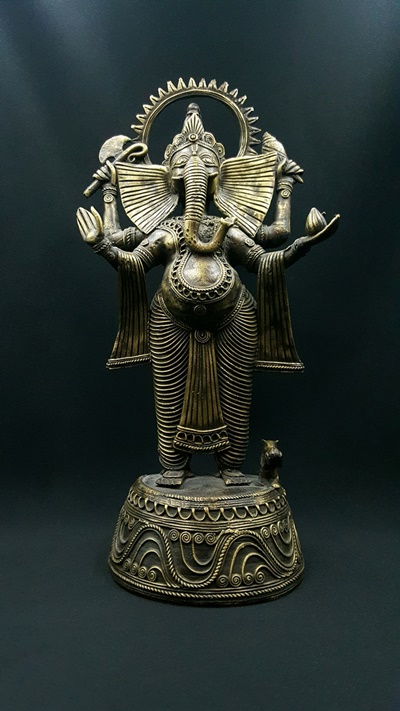
Parfois il tient un laddhu, une canne à sucre, épi de riz, une grenade, une bourse remplie de pièces d’or… signes d’abondance et de sa grande générosité.
Le Laddhu, une sucrerie, représente la douceur, le plaisir, le réconfort.
Le rat ou la souris : Mushaka, sa monture. Symbole à la fois de la convoitise, de la maladie mais aussi de la prospérité et de la richesse, de l'intelligence. Le rat peut représenter à lui seul Ganesha : il met l'accent sur l'ambivalence de Ganesha qui unit les opposés : absolu/relatif-grand/petit - mi-animal/mi-humain - esprit vif dans un corps massif.
Allégoriquement Mushaka personnifie l’égo (mush, sa racine signifie voler), dans le sens de celui qui s’approprie, du voleur : chacun vit dans son monde, est égocentré, voit le monde à partir de lui même, de ses croyances, valeurs, peurs, opinions ... Pas de neutralité pour l’égo, il colore tout et ne peut voir la réalité telle qu ‘elle est.
Ainsi Ganesha chevauche-t-il Musasha...
Ganesha est honoré partout en Inde et au delà dans le Sud Est asiatique. Les rituels, quotidiens, sont plus marqués le mardi et vendredi. Les dévots lui offrent des fruits, des fleurs, plutôt rouges mais aussi du camphre, des sucreries… Sa fête se déroule le quatrième jour du mois de Bâdhra (septembre-octobre) : Ganesha Chaturthi est particulièrement intense dans le Mahârashtra, notamment à Mumbai où les défilés sont immenses, particulièrement au moment où son image est immergée dans la mer.
Sources
Sarah Combe - Un et Multiple – Editions Dervy
Alain Daniélou : Mythes et Dieux de l’Inde
Eva Rudy janssen : Iconographie de l’hindouisme
Catherine Clément : Ballades avec les dieux de l'Inde
Il est représenté par un homme avec une tête d’éléphant, c’est le dieu hindou le plus facilement reconnaissable.
Et c’est sans doute la divinité la plus populaire, la plus vénérée de l’Inde. Les fidèles ne manquent pas de l’honorer avant toute entreprise : voyage, démarches… tout projet, quel qu’il soit fait l’objet d’une prière à Ganesha avant sa mise en œuvre. Ganesha est celui qui lèvent les obstacles (ou peut les multiplier), il est alors nommé Vighneswara.
L’histoire de sa naissance, la plus connue, est celle où Parvati, seule, se languissait des longues absences de Shiva : un jour lui vint l'idée de modeler un fils, à qui elle donna vie dans le Gange. Elle le chargea de garder ses appartements et de ne laisser entrer personne sous aucun prétexte. Shiva, rentrant chez lui, trouva un jeune homme devant sa porte : furieux, il le décapita avec son trident. Indignée et courroucée Parvati exigea auprès des Dieux qu'ils ramènent son fils à la vie avant la fin du jour : les dieux décidèrent de couper la tête du premier nouveau né trouvé qui se trouva être un éléphanteau !
Ganesha, Le seigneur des Gana
Ganesha est considéré par ses disciples les plus fervents comme le Dieu suprême, au-delà des dieux de la Trimurti (Brahma, Vishnou et Shiva).
En effet Gana signifie catégories ; les catégories permettent de mesurer (établir un rapport à autre chose, mettre en relation), de différencier, de mettre des limites entre les différentes formes.
Ganesha représente la communion du macrocosme et du microcosme, l’un étant à l’image de l’autre, l’un contenant l’autre.
En effet , au-delà de l’anecdotique histoire de sa naissance, la forme de Ganesha est particulièrement intéressante : l’éléphant symbolise le macrocosme, c’est à dire la pure conscience, l’absolu et le corps humain, la conscience manifestée. Et bien sûr la partie « Conscience » (la tête d’éléphant, Ganesh est alors nommé « Gajânaja » tête d’éléphant ou Gajâmukha visage d’éléphant) se situe au dessus du corps humain.
Cette union du macrocosme et du microcosme se lit aussi dans l’association de l’éléphant et de la souris, sa monture : le grand et le petit...
Ainsi dans une unique figuration, l’hindouisme nous invite à prendre conscience de la présence simultanée de l’absolu et de la manifestation qui ne peuvent aller l’un sans l’autre. L’illusion consiste à ne percevoir que les formes changeantes soumis au temps et à l’espace.
« Le seigneur des catégories règne sur l’intellect universel, le principe transcendant (Mahat tattva) ainsi que sur les principes des éléments (tattva-s) qui en sont dérivés » (Bhaghavat tattva).
Ganesha invoque à lui seul le célèbre mantra : Tat Tvam Asi, tu es cela ou plus précisément, cela tu es. Cela signifiant l’Absolu qui est par nature indéfinissable, au-delà des attributs, des catégories.
Ainsi le mantra évoqué pour Ganesha est-il AUM, le son primordial, celui par lequel tout advint. Il est récité avant l’accomplissement de chaque rite.
Ganesha, Celui qui lèvent les obstacles
Vighnarajâ, le seigneur d’Obstruction, est une appellation de Ganesha beaucoup moins connu mais qui est fait le pendant à Celui qui lèvent les obstacles.
Indra, roi des Dieux, courroucé de ne pas avoir été invité lors d’une cérémonie, envoya le Temps sous la forme d’Obstruction afin de se venger du prince fautif. Mais une fois, sa mission accomplie, ce génie parcourut le monde en y semant le désordre. Brahma appela alors Ganesha (maître du temps) et Obstruction, vaincu, se mit à son service.
Ainsi Ganesha, s’il n’est pas correctement honoré, peut il à l’inverse être une source d’obstacles.
Il incarne aussi la sagesse, l’intelligence, il est le dieu de l’éducation. Il est vénéré des enseignants et des professions intellectuelles. La connaissance qu’il déverse permet d’écarter les difficultés liées à l’ignorance.
Les différentes formes de Ganesha
Omkara Ganapati est la représentation de Ganesha sous la forme de Aum.
La calligraphie de ce mantra peut laisser clairement voir, sur la gauche, la trompe de Ganesha.
Balaganesh, soit Ganesh sous sa forme enfantine.
Nritya Ganapati soit Ganesha dans la position du danseur cosmique qui représente le changement, la création. Ganesha se tient sur une seule jambe légèrement fléchie tandis que le pied de l'autre est proche du genou. C'est la 15ème forme de Ganesha sur les 32 répertoriées. Ganesh a danse comme Shiva : une danse cosmique qui symbolise le changement, le mouvement qui ne cesse de se produire à tout instant même si nous le percevons pas (mais que les physiciens nous prouvent aisément aujourd'hui). C’est une des lois primordiales de la vie.
Il peut être aussi couché... cependant il est personnifié le plus souvent debout ou assis.
Les attributs fondamentaux de Ganesha
Debout, dans toute sa splendeur, dans une attitude d'ouverture, Ganesha accueille. Souvent habillé en rouge, il possède quatre bras, l’un portant le lacet, l’autre le crochet à éléphant tandis les autres font le geste de protection (abhaya) et de don (varadâ).
Sa tête possède deux grandes oreilles, symbolisant les vans qui sépare le bon grain de l’ivraie soit la vérité de l’ignorance.
Sa trompe courbée soit à gauche, soit à droite nous rappelle que le divin (appelé parfois « tordu ») est insaisissable par l’intellect et que seule l’expérience intime peut nous permettre de le connaître. Cette trompe « tordue » nous suggère aussi que le chercheur de vérité doit être habile et savoir contourner les obstacles.
Son ventre est énorme car il contient l’univers entier.
Il est souvent entouré du cordon sacré et du serpent : Naga, symbole de régénération, de changement perpétuel et de l’énergie latente. Par ailleurs, les cobras peuvent aussi lorsqu’ils sont unis former un dôme protecteur sur la tête d’une divinité.
Son unique défense (qui selon les légendes s’expliquent par la destruction de l’une d’elles lorsque Shiva coupa la tête de l’éléphanteau ou bien lors d’un féroce combat où, en ultime recours, Ganesha cassa une de ses défenses et la jeta sur l’asura (démon) Gajamukha qui opprimait le monde : celui-ci se transforma alors aussitôt en souris) symbolise le Un sans un second.
Le lacet Pâsha, est utilisé pour capturer les démons qui représente l’ignorance (les erreurs), les fausses croyances, les poisons qui nous habitent. Le lacet peut aussi illustrer les liens, l’attachement.
Le crochet indique celui qui a la faculté de voir, de guider. Anhuska sert à orienter les éléphants dans la bonne direction et par extension les disciples. Il signifie la clairvoyance de celui qui guide.
Parashu : La hache de guerre est l'arme symbolique qui tranche les liens de l'ignorance. Elle dissout les ténèbres qui obscurcissent l’esprit. Elle nous libère des liens de l’attachement (de tout ce qui nous sépare de notre nature ultime, l’absolu : croyances, démons intérieurs, biens matériels…). La présence de la hache marque donc l’intelligence, la clarté de l’esprit.
Parfois, Ganesha porte une fleur de lotus : Padma symbolise la pureté, la beauté, la perfection. Il est le sein maternel, la matrice d'où viennent toutes choses. C'est le siège du principe féminin, la Shakti.
Le lotus donne une fleur de toute beauté, alors qu'il provient d'un environnement marécageux, obscur, repoussant : il représente donc la possibilité de transformation, d'élévation.
Parfois il tient un laddhu, une canne à sucre, épi de riz, une grenade, une bourse remplie de pièces d’or… signes d’abondance et de sa grande générosité.
Le Laddhu, une sucrerie, représente la douceur, le plaisir, le réconfort.
La monture de Ganesha
Le rat ou la souris : Mushaka, sa monture. Symbole à la fois de la convoitise, de la maladie mais aussi de la prospérité et de la richesse, de l'intelligence. Le rat peut représenter à lui seul Ganesha : il met l'accent sur l'ambivalence de Ganesha qui unit les opposés : absolu/relatif-grand/petit - mi-animal/mi-humain - esprit vif dans un corps massif.
Allégoriquement Mushaka personnifie l’égo (mush, sa racine signifie voler), dans le sens de celui qui s’approprie, du voleur : chacun vit dans son monde, est égocentré, voit le monde à partir de lui même, de ses croyances, valeurs, peurs, opinions ... Pas de neutralité pour l’égo, il colore tout et ne peut voir la réalité telle qu ‘elle est.
Ainsi Ganesha chevauche-t-il Musasha...
Ganesha est honoré partout en Inde et au delà dans le Sud Est asiatique. Les rituels, quotidiens, sont plus marqués le mardi et vendredi. Les dévots lui offrent des fruits, des fleurs, plutôt rouges mais aussi du camphre, des sucreries… Sa fête se déroule le quatrième jour du mois de Bâdhra (septembre-octobre) : Ganesha Chaturthi est particulièrement intense dans le Mahârashtra, notamment à Mumbai où les défilés sont immenses, particulièrement au moment où son image est immergée dans la mer.
Sources
Sarah Combe - Un et Multiple – Editions Dervy
Alain Daniélou : Mythes et Dieux de l’Inde
Eva Rudy janssen : Iconographie de l’hindouisme
Catherine Clément : Ballades avec les dieux de l'Inde
